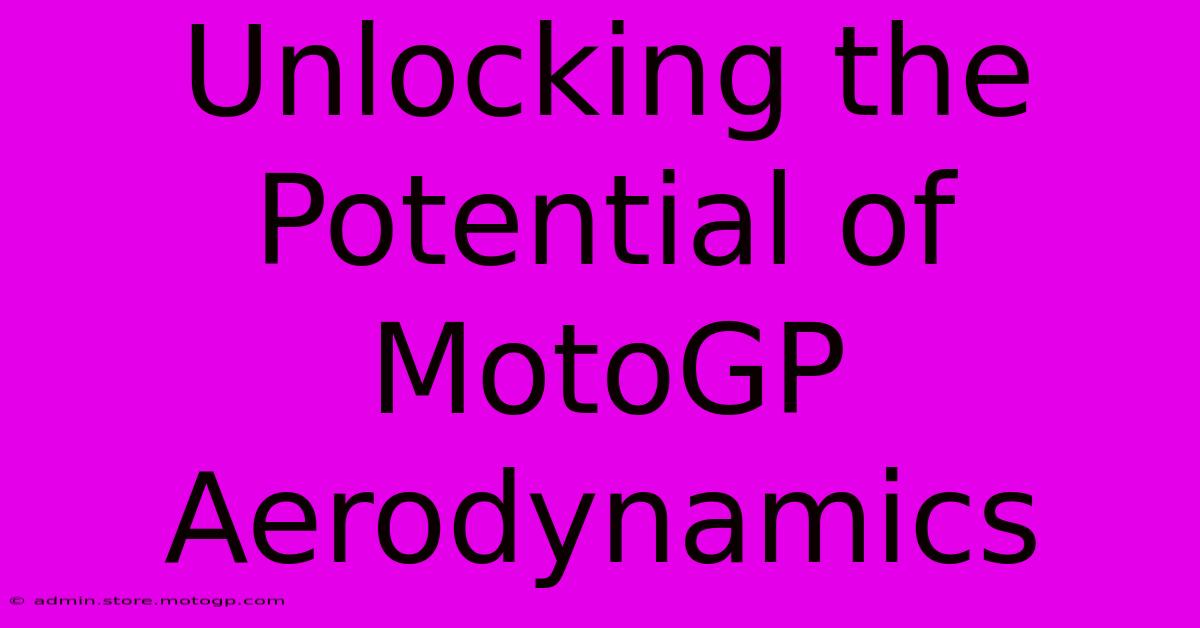Unlocking The Potential Of MotoGP Aerodynamics

Table of Contents
Unlocking the Potential of MotoGP Aerodynamics: A Deep Dive into Downforce and Drag
MotoGP, the pinnacle of motorcycle road racing, is a relentless pursuit of speed and performance. While rider skill and engine power are paramount, the often-overlooked element of aerodynamics plays a crucial, sometimes decisive, role in a rider's success. This article delves into the complex world of MotoGP aerodynamics, exploring how teams leverage downforce and minimize drag to achieve a competitive edge.
The Science of Speed: Downforce vs. Drag
At the heart of MotoGP aerodynamics lies the delicate balance between downforce and drag. Downforce, the force pushing the motorcycle towards the track, provides crucial grip at high speeds, enabling faster cornering and improved stability. Conversely, drag is the resistance the motorcycle encounters as it moves through the air, hindering acceleration and top speed.
Generating Downforce: Wings, Fairings, and More
Modern MotoGP bikes are masterpieces of aerodynamic engineering. Sophisticated winglets, strategically placed on the fairing and sometimes the swingarm, generate significant downforce. These aren't merely decorative; their design is meticulously refined through Computational Fluid Dynamics (CFD) simulations and extensive wind tunnel testing. The shape, angle, and placement of these winglets are crucial in maximizing downforce while minimizing drag. The fairing itself, sculpted with precision, contributes to downforce generation by carefully managing airflow around the motorcycle.
Minimizing Drag: Streamlining for Maximum Velocity
While downforce is essential for cornering, excessive drag can significantly hamper top speed and acceleration. Teams invest heavily in minimizing drag through meticulous design and material selection. Streamlining the motorcycle's profile, reducing the frontal area, and optimizing airflow are key strategies. Even seemingly minor details, like the shape of the mirrors or the position of the rider's body, can impact overall drag.
The Evolving Landscape of MotoGP Aerodynamics
The development of MotoGP aerodynamics is a constant arms race. Regulations often place limitations on wing sizes and shapes, forcing teams to become increasingly innovative in their designs. This leads to the development of increasingly sophisticated solutions, pushing the boundaries of what's possible. We've seen a significant evolution from rudimentary fairings to the complex, multi-element wings seen on today's bikes.
The Impact of Rider Position and Bodywork
The rider's position and the design of the rider's bodywork also play a vital role in aerodynamics. A rider's posture influences airflow around the motorcycle, impacting both downforce and drag. Teams often work closely with riders to optimize their riding position for maximum aerodynamic efficiency. The design of the rider's hump, the area behind the rider's seat, is particularly important in managing airflow and reducing drag.
The Future of Aerodynamics in MotoGP
The future of MotoGP aerodynamics promises even more innovation. We can expect to see further refinements in wing design, more sophisticated CFD simulations, and the continued exploration of new materials and manufacturing techniques. The pursuit of marginal gains in aerodynamic performance will remain a critical factor in determining the outcome of races.
Keywords: MotoGP, aerodynamics, downforce, drag, winglets, fairing, wind tunnel, CFD, streamlining, MotoGP technology, motorcycle racing, racing technology, aerodynamic design
This article provides a comprehensive overview of MotoGP aerodynamics, incorporating keywords strategically throughout the text to improve search engine optimization. The use of headings, subheadings, and bold text enhances readability and emphasizes key concepts. The article also incorporates a forward-looking perspective, anticipating future developments in the field.

Thank you for visiting our website wich cover about Unlocking The Potential Of MotoGP Aerodynamics. We hope the information provided has been useful to you. Feel free to contact us if you have any questions or need further assistance. See you next time and dont miss to bookmark.
Featured Posts
-
Did He Do It Again Find Out Who Won The Grand Prix
Feb 19, 2025
-
Moto Gp Starting Grid The Thrill Of The Launch
Feb 19, 2025
-
F1 Ratings Beyond The Numbers
Feb 19, 2025
-
Speed Moto Gp Live Your Dream
Feb 19, 2025
-
Elevate Your Riding Motorcycle Track Days At Cota
Feb 19, 2025
